Naturally, you’ll need to consider your specific content needs and workflow to get the most value from today’s top AI content writing tools. AI is now deeply embedded in content marketing, with 87% of marketers reporting they use it to assist with content creation, according to Ahrefs’s survey. Whether you’re building long-form blogs or writing ad copy, there’s likely an AI content writer that fits the bill and your budget.
This year’s best AI content writers offer powerful ways to streamline your workflow and boost productivity. We’ve compiled all the top-rated AI content writing tools for 2025 into one easy-to-scan list, complete with a breakdown of features, use cases, pricing, and pros and cons.
| AI Tool | Best For | Starting Price (Billed Monthly) |
| ChatGPT | All-purpose writing | From $20/month (Free version included) |
| Claude | Long-form content | From $20/month (Free version included) |
| Jasper AI | Marketing, brand tone consistency | From $69/month (Free trial) |
| Writesonic | SEO articles | From $49/month (Free version included) |
| Copy.ai | Short-form marketing content | From $9/ 9/month (Free version included) |
| Gemini AI | Google ecosystem, research | Google AI: From $19.99/month (Free version included) |
| Anyword | Conversion-focused copy | From $49/month |
| Frase | SEO content | From $45/month |
| Rytr | Budget-friendly writing | From $9/month (Free version included) |
| Scalenut | AI + SEO campaigns | From $49/month (Free trial) |
1. ChatGPT
OpenAI saw its weekly active users surpass 400 million in February 2025. To put it simply, our review calls ChatGPT “the most versatile and capable AI writing assistant you can use today.”
And there’s a good reason for that: ChatGPT is a complete evolution of what AI writing tools can do. It handles long-form blog posts, SEO optimization, social posts, email copy, and even code.
ChatGPT might just be one of the most important productivity tools. There are a lot of AI tools that do one thing well: summarize text, write SEO articles, and fix grammar. But ChatGPT does all of that and more. The fact that a single platform can switch between technical, creative, strategic, and operational tasks so fluidly is a big reason it’s a go-to.
I used to spend hours writing long-form articles or searching Stack Overflow. Now, most of that gets done faster. With the Plus plan, you can build Custom GPTs that are tailored to your unique tasks, workflows, or brand tone. And thanks to memory, if you need three versions of the same email rewritten every week with slight changes, it’ll keep up with things. ChatGPT is efficient at scale.

Pros of ChatGPT
- Unmatched flexibility
- Content at scale
- Build your own tailored assistants for brand tone or workflows (Plus plan)
- Personalization
- Multimodal input – Supports voice, image, document analysis, and file uploads
- Ideal for brainstorming and strategy
Cons of ChatGPT
- Occasionally, ChatGPT makes stuff up. It’ll write a super confident paragraph with citations and stats, and then you may realize later that the journal doesn’t exist or the date’s off by two years.
- Lacks real-time knowledge, unless you enable tools like browsing or connect it to live data (which is only available on certain plans).
- ChatGPT is super great at evergreen content, but not your go-to for breaking news, tech updates, or regulatory changes.
- The output is only as good as the input. If you give it vague or lazy prompts, you’ll often get safe, repetitive answers. I’ve found that to get punchy, branded content, you really have to train it with examples and iterate. Otherwise, you’ll spend more time editing than you’d like.
- The free version of ChatGPT is decent, but the real power, GPT-4.5/GPT-4o and Custom GPTs, are locked behind a $20/month Plus plan.
2. Claude
I didn’t expect Claude to win me over the way it has. Wow, things have changed fast since it launched. Claude is now one of the most structured AI content writers, especially for long-form content.
If you write technical guides, blog series, or anything that needs clarity and logic, Claude is a great option. It’s not as “chatty” as ChatGPT, but that’s actually what I love about it. Claude writes clean and sticks to the tone you give it.
Claude is also good at reasoning. It will guide you through why each section of an outline matters and how they connect.
Besides, Claude comes with Artifacts, basically a split-screen interface where you can generate text or code and view the live result side-by-side. It’s especially convenient if you’re writing HTML, creating structured documents, or embedding widgets into your content.
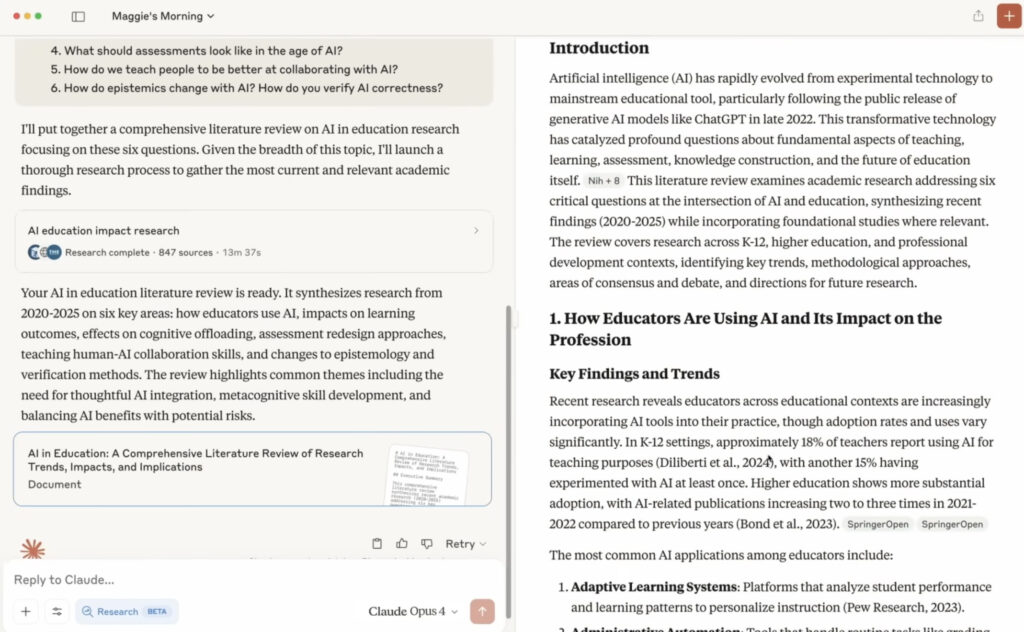
Pros of Claude
- Remarkable structure and logic
- Artifacts workspace
- Reliable tone control
- Enterprise-friendly console tools
Cons of Claude
- The free Claude plan is generous on tokens, but strict on speed. You’ll probably want the Pro plan for serious work.
- Occasionally, Claude brings an over-formal tone. It can sound a bit stiff, especially in creative or marketing-style writing.
- No image yet. Claude is fantastic at text, but unlike ChatGPT, it doesn’t currently support image generation.
3. Jasper
If you’re in marketing or content writing, chances are you’ve heard of it or tried it yourself. Jasper is an entire platform built specifically for marketers. Jasper actually helps structure your workflow and learns your brand voice.
What sets it apart is its brand voice memory. You can teach Jasper your tone, messaging pillars, and product details, and it remembers them across projects. The tool also powers ad copy, Instagram captions, and email campaigns. It’s one of the most versatile AI writing tools for content marketers.
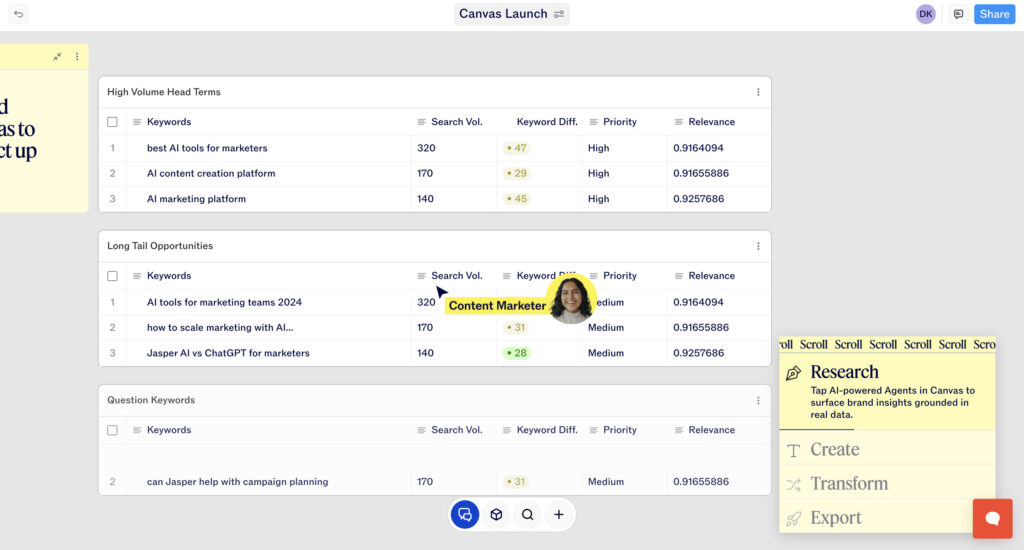
Pros of Jasper
- Built for marketers
- Brand voice memory
- Wide range of use cases (long-form content, ad copy, Instagram captions, email campaigns, and YouTube scripts)
- Custom workflows
Cons of Jasper
- Expensive
- Though Jasper has brand voice memory, the long-form output still feels templated or shallow unless you spend time refining your prompts or layering in detailed instructions.
- Less effective for short-form paid media. Jasper doesn’t perform as well on short-form ad copy, especially when compared to GPT-4o or Claude 3. It’s decent, but may require manual editing for better.
Read more: 7 Best Practices for SaaS Content Writing
4. Writesonic
Let’s bring it back to Writesonic. Writesonic is one of the smartest platforms for SEO-forward content. This tool now brings AI Visibility Tracking, which allows you to get to see where your brand shows up in AI-generated responses across platforms. (Think of it like Google Search Console, but for AI)
Instead of just giving you content templates, Writesonic analyzes AI search performance and tells you what content to write next, based on competitor wins and citation gaps. With Ahrefs and Google Keyword Planner data baked in, every blog or article is structured for search engines.
From there, its built-in writing tools (like the Sonic Editor and auto fact-checking) help you execute content strategies that are deeply researched and genuinely optimized for both traditional search and emerging AI-driven visibility.
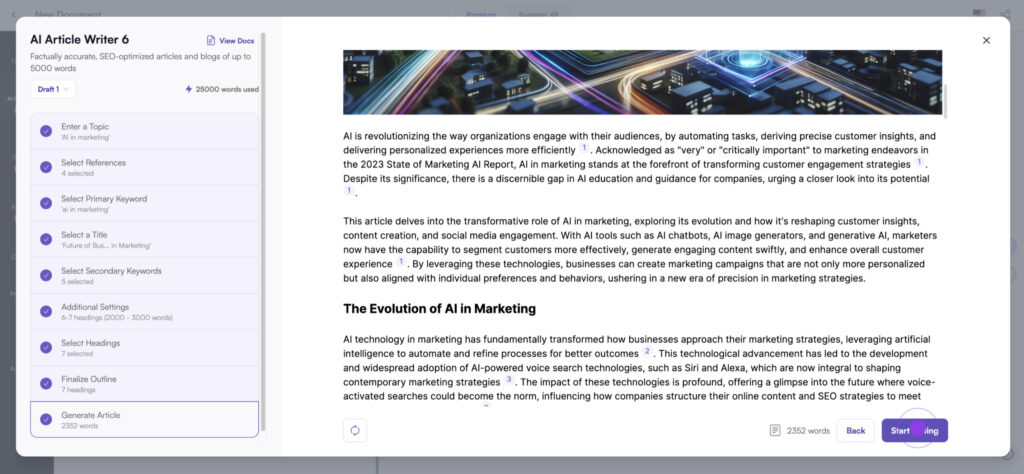
Pros of Writesonic
- AI Search Visibility Tracking
- Built-in strategy layer
- SEO-backed content
- Solid writer UI (Sonic Editor)
- Great at mid-tier, SEO-focused copy
- Strong for agencies and teams
Cons of Writesonic
- Credit limits and pricing jumps. The free plans give you a small taste, but you’ll hit the paywall fast. Some features (like advanced SEO tools or brand voice cloning) are only in premium plans, and those are not cheap.
- Occasionally shallow or repetitive. For highly technical or niche topics, you may need to enhance the depth manually. The AI can gloss over details and sometimes reuse phrasing in longer pieces.
- As good as the Sonic Editor is, navigating between projects and templates could be messy. Power users may wish for a cleaner workspace and better organization.
- Not really ideal for creative voice work. If you need edgy storytelling or emotionally charged copy, Writesonic may not hit the mark.
5. Gemini
If you’re among the many writers, researchers, or marketers searching for a free yet capable AI writing assistant, then you’ve come to the right place. Gemini has rapidly evolved into one of the most versatile tools available for content creation.
At the heart of Gemini is the 2.5 Flash model, a lean but impressively smart “thinking” model. It reasons through your prompts, cross-checks information online in real time, and helps create logically sound, well-structured content. Our review found its accuracy, real-world reasoning, and Google app integration to be the main reasons it earns a spot among the best AI content writers.
But does it beat ChatGPT? That depends on your workflow. What Gemini lacks in creativity and tone nuance, it makes up for with powerful tools, deep context understanding, and Google’s massive data ecosystem.
Pros of Gemini
- Best-in-class free plan with full web access
- Strong reasoning and real-world logic, ideal for research-heavy writing
- Smooth integration with Google Docs, Gmail, Maps, YouTube, and more
- Multimodal capabilities (text, image, video, audio)
- 2TB of storage included in the paid plan (Google One AI Pro)
Cons of Gemini
- Inconsistent or generic responses without clear prompts.
- Still behind in advanced reasoning and multi-step logic. Although improved, some users reported issues with complex instructions or longer logical chains, especially in earlier model versions.
- Full access to advanced features like long context windows or longer-form outputs requires a Google One AI Premium subscription.
- Weaker image generation capabilities. Compared to competitors, Gemini’s AI-generated visuals were described as less detailed or imaginative.
6. Copy.ai
Copy.ai started as a basic AI writing tool and is now one of the most enterprise-ready platforms for sales and marketing content. It’s not the most creative writer on this list, but it’s great for scale and integration.
If your work spans inbound content, outbound outreach, and SEO, Copy.ai is uniquely built for that ecosystem. You feed it sales transcripts, call notes, or account research, and it outputs full-funnel assets that are structured and relevant.
Copy.ai is ideal for marketers and GTM leaders who need AI to plug into their CRM or build repeatable copy engines across the org, not just generate standalone blog posts.
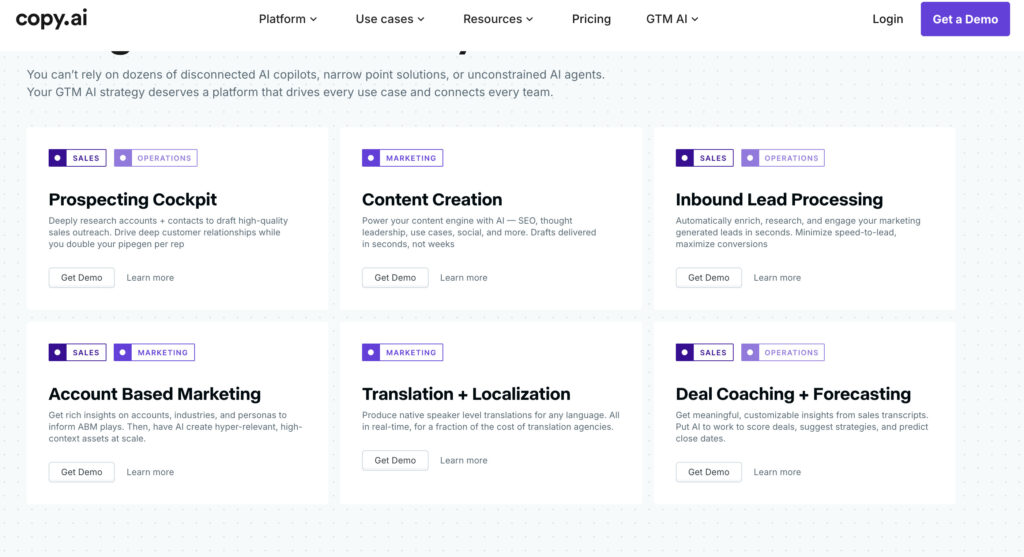
Pros of Copy.ai
- Deep GTM integration (content creation, enrichment, personalization, and ABM all in one place)
- Workflow automation
- Supports inbound + outbound
- Localization + translation
Cons of Copy.ai
- Hit-or-miss output quality. It’s best at templates, not originality. For creative storytelling or brand-sensitive messaging, Copy.ai can feel generic.
- Expensive for premium access. Enterprise pricing can get steep for advanced workflows.
7. Anyword
If your team is spending more time tweaking ad copy, Anyword could be your fix. Designed for marketers and copywriters, Anyword delivers AI-generated content backed by predictive performance scores. Its Website Agent, custom-trained models, and integration with platforms like Google and Meta make it ideal for teams that live and breathe ROI.
That is, assuming you’re comfortable navigating a slightly complex dashboard at first, and don’t mind the higher cost, because this tool is built for performance. And depending on your use case, certain features like templates for specific campaign types or audience targeting might feel less polished compared to newer rivals. But for content that converts, Anyword earns its spot.
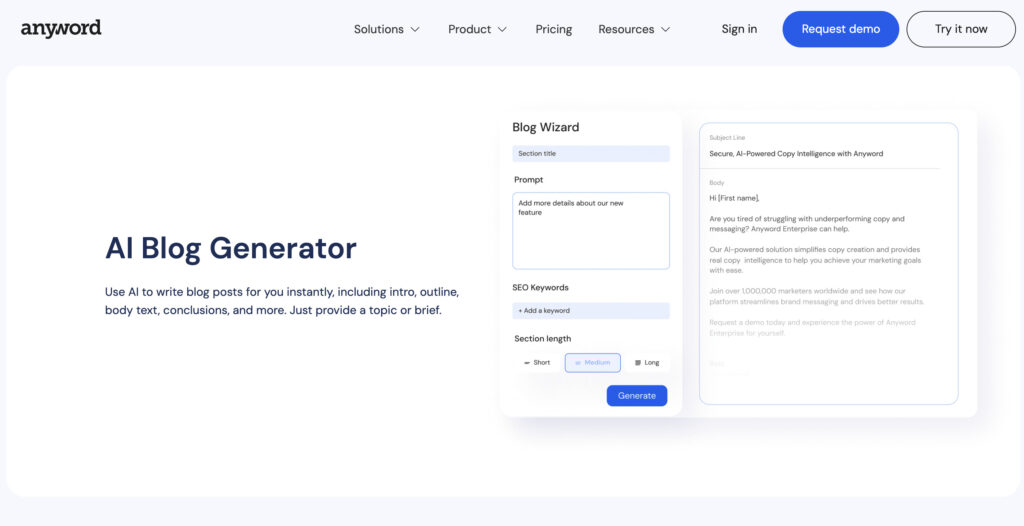
Pros of Anyword
- Predictive performance scores that guide better decisions
- Custom-trained models reflect your brand voice
- Great for blog writing and SEO-driven content
- Unified platform for ads, social, email, and website copy
- Saves time and streamlines workflows
Cons of Anyword
- Higher pricing, especially for smaller teams.
- The blog creator tool misses depth.
- Lack of creative liberty in outputs.
- Audience targeting options are limited.
8. Frase
Along with Jasper and Writesonic, Frase is one of the go-to platforms for content marketers. Frase is an AI-powered content writer and optimizer specifically for SEO teams, agencies, and creators aiming to rank on Google and stay visible across next-gen AI search like ChatGPT’s browsing and Perplexity.
Frase does more writing content. It researches your topic, analyzes competitors, and helps you structure blog posts and guides with all the right keywords, headings, and FAQs. Also, Frase makes it easy to stay organized with folders, assignments, and Google Docs and WordPress integrations.

Pros of Frase
- SERP-powered research
- SEO-friendly content briefs
- All-in-one writing and optimization workspace
- Templates and repeatable workflows
- Solid integration with Google Docs & WordPress
Cons of Frase
- Limited tutorials and language support
- The tool excels at structure, but is not really great for creative or emotional storytelling
- No AI image generation. Unlike ChatGPT or Gemini, Frase focuses purely on text. If you’re looking for visuals, you’ll need a separate tool.
9. Rytr
If your writing workflow lives in emails, social media, and blog intros, Rytr is one of the fastest and easiest AI content writers to get started with. It’s a browser-based tool for marketers, freelancers, and small businesses.
Rytr mainly focuses on short-form content with its features like paragraph expansion, rewording tools, tone mirroring, and an autocomplete that helps you finish sentences as you write.
While it may not match the depth of Jasper or the predictive analytics of Anyword, Rytr keeps it simple, fast, and effective. It’s a writing assistant for blog outlines, product descriptions, and email replies.
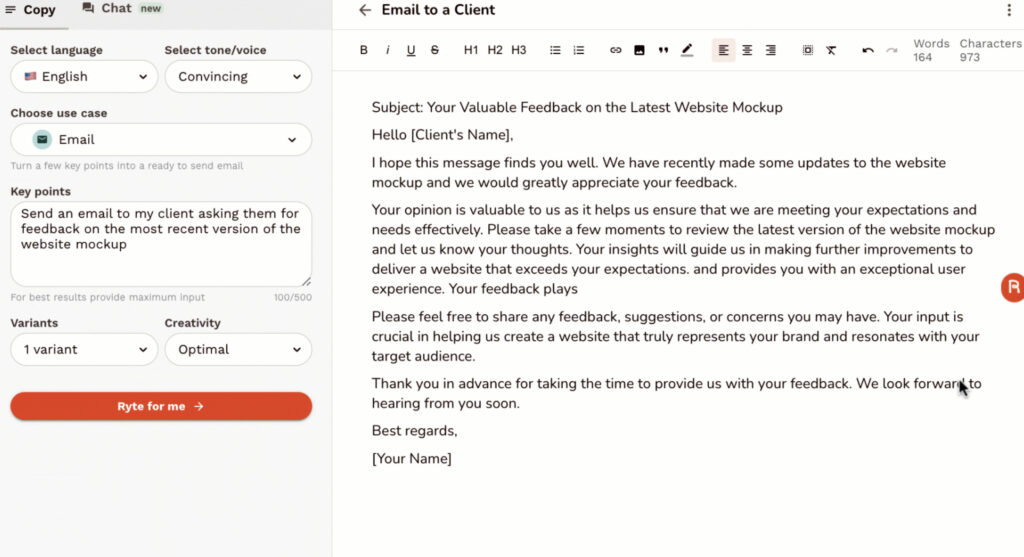
Pros of Rytr
- Extremely user-friendly interface
- Great for short-form content and social media
- Custom tone of voice from your own writing
- Feature-rich (paragraph expansion, rephrasing, grammar checks, sentence shorteners)
- Free plan that actually works ( Rytr’s free tier is generous enough for casual or occasional use)
Cons of Rytr
- Not ideal for deep or long-form writing. Rytr can draft basic blog posts, but it lacks research assistance, formatting tools, and SERP analysis.
- Limited creative writing or storytelling tools.
- Monthly usage limits. The free plan caps your output, and paid tiers can feel a little tight if you’re generating high-volume content regularly.
- If you’re in a hurry and don’t adjust tone settings, the content might come out too stiff or too casual, especially for more formal industries.
- No PowerPoint or visual content generation
10. Scalenut
We’ve seen big improvements across the board in AI content tools, and Scalenut stands out in one area: it’s built from the ground up for AI-first SEO. If you’re writing content that needs to rank in Google and show up in AI search results like ChatGPT, this platform has the tools to help you do just that.
Scalenut combines a powerful AI writer with a full-stack GEO system. That means it helps you write, plan topics, cluster keywords, track AI visibility, and more, all in one sleek platform.
Pros of Scalenut
- Cruise Mode for structured long-form content
- GEO Core dashboard for planning, writing, and optimization
- Built-in keyword clustering and topic scoring
- Tracks how AI engines see, cite, and rank your brand
Cons of Scalenut
- While the platform creates well-structured content, it can sound generic or robotic, especially for brand voice or emotional depth.
- Smaller plans come with usage limits, which can be restrictive if you’re producing content in bulk or running multiple domains.
- Although the platform produces content well, it can be, at worst, robotic-sounding, especially in the case of brand voice or emotional depth.
- There are smaller plans, but they will be limited in usage; this can be very restrictive if you’re producing content in bulk or running multiple domains.
Expert opinion
The future of AI is not about replacing humans; it’s about augmenting human capabilities.

CEO of Google
Conclusion
For what kind of AI writing tool will you go for? This all depends on your workflow and budget. For example, tools like Rytr are great if you only require quick, affordable writing assistance for basic tasks. In case you are frequently creating high-quality content for business, SEO, or brand storytelling, then use one of the premium tools, such as ChatGPT or Writesonic, for better control, output, and integration.
Frequently Asked Questions





